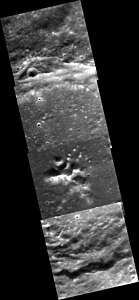
Caloris Planitia is a plain within a large impact basin on Mercury, informally named Caloris, about 1,550 km (960 mi) in diameter. It is one of the largest impact basins in the Solar System. "Calor" is Latin for "heat" and the basin is so-named because the Sun is almost directly overhead every second time Mercury passes perihelion. The crater, discovered in 1974, is surrounded by the Caloris Montes, a ring of mountains approximately 2 km (1.2 mi) tall.
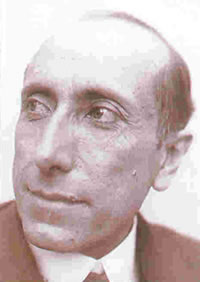
Amado Nervo also known as Juan Crisóstomo Ruiz de Nervo, was a Mexican poet, journalist and educator. He also acted as Mexican Ambassador to Argentina and Uruguay. His poetry was known for its use of metaphor and reference to mysticism, presenting both love and religion, as well as Christianity and Hinduism. Nervo is noted as one of the most important Mexican poets of the 19th century.
The Caloris Montes are a range of mountains on Mercury. They are a system of linear hills and valleys that extend more than 1000 km to the northeast from the mountainous rim of Caloris Basin in the Shakespeare quadrangle (H-3). The range consists of numerous rectilinear massifs 1 to 3 km high and about 10 to 50 km long, mostly elongated radially from the center of the basin and separated by hackly-floored, radial troughs and gouge-like structures.
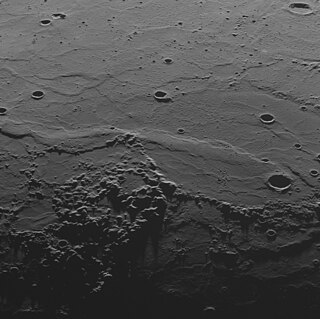
Odin Planitia is a large basin on Mercury. It was named after the Norse god Odin in 1976 by the IAU. It was first observed in detail by Mariner 10. The plain is approximately 473 kilometers in diameter.
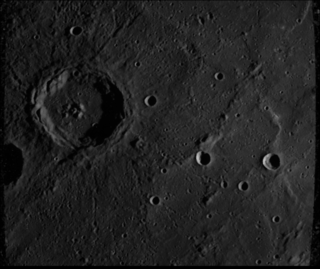
Zola is a crater on Mercury. The crater was named after the French novelist and playwright Émile Zola by the IAU in 1979.

The Tolstoj quadrangle in the equatorial region of Mercury runs from 144 to 216° longitude and -25 to 25° latitude. It was provisionally called "Tir", but renamed after Leo Tolstoy by the International Astronomical Union in 1976. Also called Phaethontias.

The Shakespeare quadrangle is a region of Mercury running from 90 to 180° longitude and 20 to 70° latitude. It is also called Caduceata.
The Caloris group is a set of geologic units on Mercury. McCauley and others have proposed the name “Caloris Group” to include the mappable units created by the impact that formed the Caloris Basin and have formally named four formations within the group, which were first recognized and named informally by Trask and Guest.

The Michelangelo quadrangle is in the southern hemisphere of the planet Mercury, where the imaged part is heavily cratered terrain that has been strongly influenced by the presence of multiring basins. At least four such basins, now nearly obliterated, have largely controlled the distribution of plains materials and structural trends in the map area. Many craters, interpreted to be of impact origin, display a spectrum of modification styles and degradation states. The interaction between basins, craters, and plains in this quadrangle provides important clues to geologic processes that have formed the morphology of the mercurian surface.

Alessandro Calori is an Italian football coach and former player, last in charge as head coach of Ternana. As a defender, he is mostly remembered for his lengthy spell with Udinese during the 90s, where he also served as the club's captain.

Mozart is a crater on Mercury, named by the IAU in 1976 after Austrian composer Wolfgang Amadeus Mozart.
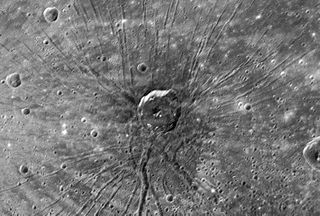
The Pantheon Fossae are a radial set of troughs in a region in the middle of Caloris Basin on Mercury. They appear to be a set of graben formed by extensional faults, with a 40 km crater located near the center of the pattern. The exact origin of this pattern of troughs is not currently known. The feature was nicknamed "the Spider" before receiving its official name.

Apollodorus is an impact crater on Mercury. Its unusual appearance, with radiating dark troughs, led to a nickname of "the Spider" by scientists before its official name was decided. Apollodorus is located near the center of Pantheon Fossae, which is a system of radial grabens situated in the inner part of the Caloris basin. The floor, rim and walls of Apollodorus expose a low reflectance material (LRM) excavated during the impact from beneath the light volcanic plains, which cover the central part of the Caloris.

Located in the western edge of Mercury's giant Caloris basin, Kertész crater has some unusual, bright material located on its floor. Sander crater, located in the northwestern edge of Caloris basin, also shows bright material on its floor. Just northeast of Kertész a small crater has very bright rays and ejecta, indicating that the crater is young.

Atget crater is distinctive on the planet Mercury's surface due to its dark color. Atget crater is located within Caloris basin, near Apollodorus crater and Pantheon Fossae. The dark color of the floor of Atget is in contrast to other craters within Caloris basin that exhibit bright materials on their floors, such as the craters Kertész and Sander. Other craters on Mercury, such as Bashō and Neruda, have halos of dark material but the dark material does not cover the crater floors.
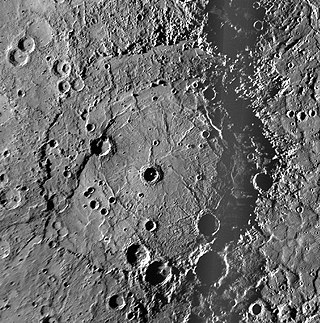
Rembrandt is a large impact crater on Mercury. With a diameter of 716 km it is the second-largest impact basin on the planet, after Caloris, and is one of the larger craters in the Solar System. It was discovered by MESSENGER during its second flyby of Mercury on October 6, 2008. The crater is 3.9 billion years old, and was created during the period of Late Heavy Bombardment. The density and size distribution of impact craters along Rembrandt's rim indicate that it is one of the youngest impact basins on Mercury.

The crater Oskison is located in the far northern hemisphere of Mercury, in the plains north of Caloris basin. Oskison is a distinctive crater with a large central peak that exposes material excavated from depth. Many chains of secondary craters are visible radiating from Oskison outward onto the surrounding smooth plains, known as Stilbon Planitia.

Raditladi is a large impact crater on Mercury with a diameter of 263 km. Inside its peak ring there is a system of concentric extensional troughs (graben), which are rare surface features on Mercury. The floor of Raditladi is partially covered by relatively light smooth plains, which are thought to be a product of the effusive volcanism. The troughs may also have resulted from volcanic processes under the floor of Raditladi. The basin is relatively young, probably younger than one billion years, with only a few small impact craters on its floor and with well-preserved basin walls and peak-ring structure. It is one of 110 peak ring basins on Mercury.

Balanchine is a crater on the planet Mercury. It possesses a ray system of slightly bluish rays. These rays inspired the name of the crater due to their similarity to the tutu in George Balanchine's Serenade.

Nervo are an Australian DJ duo comprising twin sisters Olivia and Miriam Nervo. After signing with Sony/ATV Music Publishing at 18 years of age, the sisters pursued careers as songwriting partners and in 2008 they signed with Fredrik Olsson and his Swedish music publishing company Razor Boy Music Publishing, which led to co-writing the Grammy Award-winning single, "When Love Takes Over", performed by David Guetta and Kelly Rowland.


